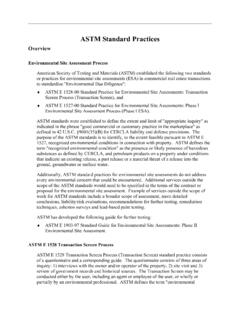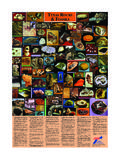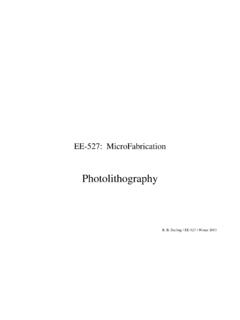Transcription of TEXAS ROCKS & FOSSILS
1 2 11. TEXAS ROCKS . 1 10. 3 4. & FOSSILS . 6 8 9 12. 13. 5. 7. 17 18. 19. 21. 14 15 16 22. 20. 31. 24. 25 26 27 29. 32. 23. 30. 28. 42 43. 33 34 35 36. 38. 40 41. 44. 46. 37 45. 47. 48. 39 51 53. 49 50. 56. 54. 55. 57 52. 58. 64 65 59 60 61 62. 63. 66. 67. 80. 70 71 73 68 69. 74 76. 72. 77 78 79. 75. 1. Abundant in many TEXAS localities, fossil seashells are found in a 14. Cretaceous marine FOSSILS from a cave along the Colorado River 30. A nodule of banded blue agate from near Alpine in West TEXAS . 43. Llanite is a type of TEXAS pink granite found nowhere else in the 58. Soapstone, a combination of talc and other minerals, is soft and 72. Specimen of natural pink granite from Burnet County. Also see variety of settings, from blackland prairies to rocky hillsides. Indi- in Travis County. The county is bisected by a major geological Similar specimens are not uncommon throughout much of the world.
2 Llanite's uniqueness results from crystals of sky-blue easily cut. Fire resistant soapstone lined the inside, or formed the numbers 64, 71 and 73. vidual specimens like these are usually from the Cretaceous pe- feature, the Balcones Escarpment. length of the Rio Grande. Also see numbers 17,18, and 26. quartz mingled with the granite's rusty-pink feldspar and other mantel of many early Central TEXAS fireplaces. Blanco County 73. Called graphic granite from the peculiar geometric inclusions that riod of some 100 million years ago. They may be actual fossil 15. Typical fossil coral. Over millions of years, skeletons of these 31. A favorite material for lapidary work is petrified palm wood. minerals. near Johnson City. give the appearance of strange hieroglyphics. Llano County. specimens, molds as shown in number 23, or casts like the heart marine animals were calcified into enormous layers of rock.
3 They Crosscut sections show the straws pattern, while longitudinal 44. Hematite, an iron oxide ore, is abundant in Northeast TEXAS . Per- 59. Travertine is a water-deposited, calcite cave mineral, and can be cockle pictured here. Fossil snails, scallops, whelks, tusk shells 74. Two more samples of TEXAS marble. One looks like man-made inhabited inland seas that once covered far West TEXAS . cuts may exhibit branching tree-like forms. Also see numbers haps surprisingly, similar iron-ore specimens varying from black of spectacular beauty in color and natural form. This polished yel- terrazzo, but it's natural! Burnet County. Also see number 63. and corals are also commonly found. Pictured FOSSILS from 3/4 9,12, 21 and 32. to steel gray may often be found in many other parts of TEXAS . low specimen is from a Burnet County cave. inch to 7 inches; all Central TEXAS . 16. Halite, also known as common table salt, forms crystals in dry un- 75.
4 Tektites, in TEXAS classified as bediasites, are rare globs of dark- derground areas. Huge salt domes lie under the coastal plains 32. Petrified palm wood in its many forms and colors is most plenti- 45. Goethite, another form of iron ore, is distinguished from hematite 60. Sandstone, a common sedimentary rock, is found in colors from colored natural glass that often show the heat pits and molten 2. These fossilized marine pelecypods are sprinkled with shiny and in West TEXAS . Marion County. ful in a broad band along the length of the Gulf Coast section, (number 44) by its higher water content. Smith County. virtually pure white to solid black. Formed of sand cemented by specks of marcasite, a mineral chemically identical to iron pyrite. surface flow typical of objects that passed through the atmo- 17. This agate type is sometimes called Christmas agate because about a hundred miles inland from the present coastline.
5 46. Selenite is among the more common minerals of TEXAS , but a silica or iron oxides, some types are soft and easily abraded; oth- sphere at extreme speed. Marble-sized to one inch in diameter. Travis County. Smithville-La Grange area. ers are virtually impervious to weathering, even tougher than of its red, green and white colors. Despite the uneven, channeled host of impurities and conditions of formation produce an aston- Washington County. 3. Pennsylvanian FOSSILS in limestone dating from the Paleozoic appearance, the primary surface is actually flat and polished. Big 33. A form of gypsum, selenite crystals are similar to, but softer than ishing variety of shapes and colors. Jim Hogg County. Also see granite! Rough and grainy to the touch. Lampasas County. era some 300 million years ago. McCulloch County. 76. TEXAS serpentine. Blanco and Gillespie Counties. Bend region. Also see numbers 18, 26 and 30.
6 Calcite and not as brittle. Found in rock cavities of several South numbers 33 and 34. 61. Geode. While commonly thought of as spherical, many irregular 4. Track of a theropod dinosaur from Dinosaur Valley State Park TEXAS and Gulf Coast counties, formed by solutions in contact shapes contain cavities. Milky quartz lines this specimen from 77. Although relatively soft, TEXAS serpentine takes a beautiful lus- 18. TEXAS agate. When cut and polished its beauty and characteris- 47. Calcite is another common TEXAS mineral, ranging from transpar- trous polish. It is widely used for terrazzo floors, decorative ob- near Glen Rose in North Central TEXAS . The site contains a host tics are easily recognized, but in its natural state it is far from with surrounding ROCKS . Port Isabel area. Also see numbers 34 ent, rhomb-shaped crystals to specimens such as number 56, Jeff Davis County. Also see numbers 54, 62, 69 and 80.
7 Of tracks made from some 100 million years ago in limey mud, and 46. jects and as Verde antique wainscot in office building and hotel spectacular and requires a practiced eye to find and judge as to and types of travertine, number 59. Real County. 62. A characteristic of limestone geodes is that many have no appar- lobbies. now turned to stone. quality. West TEXAS . Also see numbers 17, 26 and 30. 34. Another color variety of selenite crystal are these rosettes from ent, definable shell. What appears to be a block of solid lime- 48. Alibates flint was prized by ancient man for tools and weapons. 78. Cinnabar is the name for mercury ore, once mined extensively in 5. Replica of the 12-foot-high, 50-foot-long Tyrannosaurus Rex, 19. A tumble-polished silicified fern bud from Live Oak County. Gulf Palo Duro Canyon in the TEXAS High Plains. Also see numbers Quarried near Lake Meredith in the TEXAS High Plains for about stone may contain a void like this one, lined with calcite.
8 Val whose tracks are preserved in stone in Dinosaur Valley State 33 and 46. Verde County. the area around Terlingua, West TEXAS . High grade ore is heavy, Coast region of South TEXAS . 12,000 years, it was traded over much of North America. dark red or yellowish red, and shiny or lustrous. Lower grades Park (see number 4). The creature was once the world's largest 35. Fluorite crystals, colors range from clear to purple, blue, pink, 63. Typical example of marble from the Marble Falls area of Central land carnivore. 20. Another example of lustrous opalized wood. Fayette County. Also 49. TEXAS ' finest specimens of gem-quality epidote are found in Cen- are duller and earthy, and some may appear only as a red wash see number 13. green, brown and white. Found in Central TEXAS (Burnet County) tral TEXAS area between Fredericksburg and Llano. TEXAS . Also see number 74. on other ROCKS . Brewster County.
9 6. Crinoidal limestone, often composed almost entirely of FOSSILS , is and in the Eagle Mountains, Hudspeth County, West TEXAS . 64. TEXAS is famous for red and pink granites, widely employed for found in North Central, Central and West TEXAS , dating from the 21. Longitudinal section (with the grain) of petrified palm wood in 50. Novaculite is a chalcedonic rock popular for whetstones when cut 79. Septarian nodules. Dark interior areas of this specimen are he- which the straws are not evident. Also see numbers 9,12, 31 36. Common opal, a silicon dioxide like quartz , flint, and agate, is in slabs. Although usually opaque white, these samples illustrate architectural purposes. This finished specimen on the Capitol matite, and the white dividers are aragonite. From the Bosque Pennsylvanian period. The plant-like animals grew in prehistoric without the crystalline structure of those harder minerals.
10 It is ac- grounds in Austin displays the polish granite takes. Also see seas, with long stems like columns of discs. Such stem frag- and 32. the range of colors that may be found. Brewster County. River area near Waco. tually an amorphous hardened gel with high water content. TEXAS numbers 70 through 73 for more about pink granite. ments are the most frequent fossil finds. Burnet and Llano Coun- 22. This section of agatized wood from Fayette County shows evi- specimens may be white yellow, red, blue, brown or colorless. 51. Marcasite, chemically identical to iron pyrite, has a different crys- 80. A thunder egg geode from West TEXAS , lined with banded agate. ties. dence of tree rings. Various types of petrified woods are found in talline structure, but the two are often difficult to distinguish be- 65. quartz crystals. Colors range from transparent to milky white, Thunder egg is a fanciful name for geodes believed to have Central and West TEXAS .






